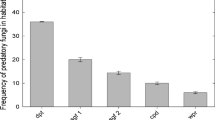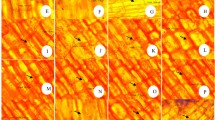Abstract
With the development of anthelmintic resistance of parastic nematodes, it is necessary to isolate and study nematophagous fungi to screen out the native isolates for their potential in the biocontrol of domestic animal nematodosis. This study aimed to isolate the Arthrobotrys sinense (Monacrosporium sinense) of nematophagous fungus, to characterize representative molecular isolates using scanning electron microscope (SEM), and to determine the effect of the temperature and pH values on radial growth of the isolate. Five isolates were isolated from 1532 samples of different types, and their occurrence frequencies were 0.32% of the total samples. They were identified as A. sinense by means of morphology and the sequence of the 5.8S, 18S, and 28S rDNA, as well as internal transcribed spacers 1 and 2. The isolate NBS003 could grow from 11°C to 35°C and had optimal growth at 30°C. The isolate could grow at pH 4 to 11, and its optimal value was obtained at pH 9. SEM results showed that 6 h after their addition, the second stage larvae (L2) and the third stage infective larvae (L3) of Haemonchus contortus were captured. L2 and L3 were penetrated by the fungus at 18 and 24 h post-capture, respectively. L2 and L3 were completely digested at 84 and 90 h post-capture, respectively. The NBS003 of the A. sinense should have a certain potential to be used for capturing the free-living stage of nematodes in sheep.
Similar content being viewed by others
References
Barçante, J.M., Barçante, T.A., Dias, S.R., Vieira, L.Q., Lima, W.S., Negrão-Corrêa D. 2003. A method to obtain axenic Angiostrongylus vasorum firststage larvae from dog feces. Parasitology Research, 89, 89–93. DOI: 10.1007/s00436-002-0719-z
Boguś M.I., Czygier, M., Kedra, E., Samborski J. 2005. In vitro assessment of the influence of nutrition and temperature on growing rates of five Duddingtonia flagrans isolates, their insecticidal properties and ability to impair Heligmosomoides polygyrus motility. Experimental Parasitology, 109, 115–123. DOI: 10.1016/j.exppara.2004.12.001
Braga, F.R., Araújo J.V. 2014. Nematophagous fungi for biological control of gastrointestinal nematodes in domestic animals. Applied Microbiology and Biotechnology, 98, 71–82. DOI: 10.1007/s00253-013-5366-z
Braga, F.R., Silva, A.R., Carvalho, R.O., Araújo, J.V., Guimarães P.H., Fujiwara R.T. et al. 2010. In vitro predatory activity of the fungi Duddingtonia flagrans, Monacrosporium thaumasium, Monacrosporium sinense and Arthrobotrys robusta on Ancylostoma ceylanicum third-stage larvae. Veterinary Microbiology, 20, 183–186. DOI: 10.1016/j.vetmic.2010.05.003
Cai, K.Z., Liu, J.L., Liu, W., Wang, B.B., Xu, Q., Sun, L.J., et al. 2016. Screening of different sample types associated with sheep and cattle for the presence of nematophagous fungi in China. Journal of Basic Microbiology, 56, 214–228. DOI: 10.1002/jobm.201500281
Campos, A.K., Araújo, J.V., Guimarães M.P. 2008. Interaction between the nematophagous fungus Duddingtonia flagrans and infective larvae of Haemonchus contortus (Nematoda: Trichostrongyloidea). Journal of Helminthology, 82, 337–341. DOI: 10.1017/S0022149X08032203
Campos, R.A., Boldo, J.T., Pimentel, I.C., Dalfovo, V., Araújo W.L., Azevedo, J.L., et al. 2010. Endophytic and entomopathogenic strains of Beauveria sp. to control the bovine tick Rhipicephalus (Boophilus) microplus. Genetics and Molecular Research, 9, 1421–1430. PMID:20662157
Duddington C.L. 1955. Notes on the technique of handling predaceous fungi. Transactions of the British Mycological Society, 38, 97–103
Falbo, M.K., Soccol, V.T., Sandini, I.E., Vicente, V.A., Robl, D., Soccol C.R. 2013. Isolation and characterization of the nematophagous fungus Arthrobotrys conoides. Parasitology Research, 112, 177–185. DOI: 10.1007/s00436-012-3123-3
Falzon, L.C., van Leeuwen, J., Menzies, P.I., Shakya, K.P., Jones-Bitton A., Sears, W., et al. 2013. Anthelmintic resistance in sheep flocks in Ontario. Canada Veterinary Parasitology, 193, 150–162. DOI: org/10.1016/j.vetpar.2012.11.014
Grønvold, J., Wolstrup, J., Nansen, P., Larsen, M., Henriksen, S.A., H. Bjørn., et al. 1999. Biotic and abiotic factors influencing growth rate and production of traps by the nematode-trapping fungus Duddingtonia flagrans when induced by cooperia oncophora larvae. Journal of Helminthology, 73, 129–136. DOI: 10.1017/S0022149X99000190
He, S.Y., Ge Q.X. 1987. The mycoflora of cotton root-knot nematode (meloidogyne incognata). Acta Phytopathologica Sinica, 17, 14–21
Hsueh, Y.P., Mahanti, P., Schroeder, F.C., Sternberg P.W. 2013. Nematode-trapping fungi eavesdrop on nematode pheromones. Current Biology, 23, 83–86. DOI: 10.1016/j.cub.2012.11.035
Inoué T., Osatake H. 1988. A new drying method of biological specimens for scanning electron microscopy: the t-butyl alcohol freeze-drying method. Archives of Histology and Cytology, 51, 53–59. PMID:3137948
Kelly, P., Good, B., Hanrahan, J.P., Fitzpatrick, R., de Waal T. 2009. Screening for the presence of nematophagous fungi collected from Irish sheep pastures. Veterinary Parasitology, 165, 345–349. DOI: 10.1016/j.vetpar.2009.07.026
Li, J., Zou, C., Xu, J., Ji, X., Niu, X., Yang, J., et al. 2015. Molecular mechanisms of nematode-nematophagous microbe interactions: basis for biological control of plant-parasitic nematodes. Annual Review of Phytopathology, 53, 67–95. DOI: 10.1146/annurev-phyto-080614-120336
Li, T.F., Zhang, K.Q., Liu X.Z. 2000. Taxonomy of Nematophagous Fungi. Chinese Scientific and Technological Publication, Beijing
Liu, W., Han, Y., Wang, B.B., Sun, L.J., Chen, M.Y., Cai, K.Z., et al. 2015. Isolation, identification, and characterization of the nematophagous fungus Monacrosporium salinum from China. Journal of Basic Microbiology, 55, 992–1001. DOI: 10.1002/jobm.201400909
Liu, X.Z., Zhang K.Q. 1994. Nematode-trapping species of Monacrosporium with special reNematode-trapping species of Monacrosporium with special reference to two new species ference to two new species. Mycological Progress, 98, 863. Doi: 10.1016/S0953-7562(09)80255-4
Li, Y., Hyde, K.D., Jeewon, R., Cai, L., Vijaykrishna, D., Zhang K. 2005. Phylogenetics and evolution of nematode-trapping fungi (Orbiliales) estimated from nuclear and protein coding genes. Mycologia, 97, 1034–1046. PMID:16596955
Maciel, A.S., Araújo, J.V., Campos, A.K., Benjamin, L.A., Freitas L.G. 2009. Scanning electron microscopy of Ancylostoma spp. dog infective larvae captured and destroyed by the nematophagous fungus Duddingtonia flagrans. Micron, 40, 463–470. DOI: 10.1016/j.micron.2008.12.007
Manueli, P.R., Waller, P.J., Faedo, M., Mahommed F. 1999. Biological control of nematode parasites of livestock in Fiji: screening of fresh dung of small ruminants for the presence of nematophagous fungi. Veterinary Parasitology, 81, 39–45. PMID:9950327
Nordbring-hertz B. 1983. Dialysis membrane technique for studying microbial interaction. Applied and Environmental Microbiology, 45, 290–293
Nordbring-Hertz, B., Friman, E., Veenhuis M. 1989. Hyphal fusion during initial stages of trap formation in Arthrobotrys oligospora. Antonie Van Leeuwenhoek International Journal of General and Molecular Microbiology, 55, 237–244. PMID: 2757366
Ojedarobertos, N.F., Torresacosta, J.F., Ayalaburgos, A.J., Sandovalcastro C.A., Valerocoss, R.O., Mendozadegives P. 2009. Digestibility of Duddingtonia flagrans chlamydospores in ruminants: in vitro and in vivo studies. Bmc Veterinary Research, 5, 1–7. DOI: 10.1186/1746-6148-5-46
Olthof, H.A., Estey R.H. 1965. Relation of some environmental factors to growth of several nematophagous Hyphomycetes. Canadian Journal of Microbiology, 11, 939–946. PMID: 5893825
Paz-Silva, A., Francisco, I., Valero-Coss, R.O., Cortiñas, F.J., Sánchez J.A., Francisco, R., et al. 2011. Ability of the fungus Duddingtonia flagrans to adapt to the cyathostomin egg-output by spreading chlamydospores. Veterinary Parasitology, 30, 277–282. DOI: 10.1016/j.vetpar.2011.02.014
Saitou, N., Nei M. 1987. The neighbor-joining method: A new method for reconstructing phylogenetic trees. Molecular Biology and Evolution, 4, 406–425. PMID: 3447015
Sargison N.D. 2012. Pharmaceutical treatments of gastrointestinal nematode infections of sheep—future of anthelmintic drugs. Veterinary Parasitology, 189, 79–84. DOI: 10.1016/j.vetpar.2012.03.035
Sissay, M.M., Asefa, A., Uggla, A., Waller P. J. 2006. Anthelmintic resistance of nematode parasites of small ruminants in eastern ethiopia: exploitation of refugia to restore anthelmintic efficacy. Veterinary Parasitology, 135, 337–346
Swe, A., Li, J., Zhang, K.Q., Pointing S.B. 2011. Nematode-trapping fungi. Current Research in Environmental and Applied Mycology, 1, 1–26
Tucker, S.L., Talbot N.J. 2001. Surface attachment and pre-penetration stage development by plant pathogenic fungi. Annual Review of Phytopathology, 39, 385–417. DOI: 10.1146/annurev.phyto.39.1.385
Tunlid, A., Jansson S. 1991. Proteases and their involvement in the infection and immobilization of nematodes by the nematophagous fungus Arthrobotrys oligospora. Applied and Environmental Microbiology, 57, 2868–2872. PMID: 16348563
Wang, B.B., Liu, W., Chen, M.Y., Li, X., Han, Y., Xu, Q., et al. 2015. Isolation and characterization of china isolates of Duddingtonia flagrans, a candidate of the nematophagous fungi for biocontrol of animal parasitic nematodes. Journal of Parasitology, 101, 476–484. DOI: 10.1645/14-715.1
Wang, B.B., Wang, F.H., Xu, Q., Wang, K.Y., Xue, Y.J., Ren, R., et al. 2017(a). In vitro and in vivo studies of the native isolates of nematophagous fungi from China against the larvae of trichostronglides. Journal of Basic Microbiology, 57, 265–275. DOI: 10.1002/jobm.201600620
Wang, F.H., Xu, Q., Wang, B.B., Wang, K.Y., Xue, Y.J., Cai, B., et al. 2017(b). Isolation, identification and characterization of the nematophagous fungus Arthrobotrys thaumasia (Monacrosporium thaumasium) from China. Biocontrol Science and Technology, 27, 378–392. DOI: 10.1080/09583157.2017.1291908
White, T.J., Bruns, T., Lee, S., Taylor J. 1990. Amplification and direct sequencing of fungal ribosomal RNA genes for phylogenetics. PCR Protocols: A Guide to Methods and Applications, 18, 315–322
Zhang, K.Q., Hyde K.D. 2014. Nematode-trapping Fungi. In Fungal Diversity Research Series, 23, 41–210
Author information
Authors and Affiliations
Corresponding author
Rights and permissions
About this article
Cite this article
Xue, YJ., Li, EL., Jing, CX. et al. Isolation, identification and characterization of the nematophagous fungus Arthrobotrys (Monacrosporium) sinense from China. Acta Parasit. 63, 325–332 (2018). https://doi.org/10.1515/ap-2018-0037
Received:
Revised:
Accepted:
Published:
Issue Date:
DOI: https://doi.org/10.1515/ap-2018-0037




